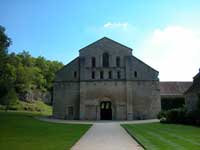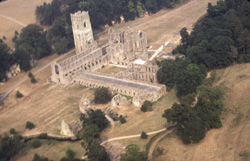 |
 |
 |
 |
 |
 |
 |
 Cistercian administration: visitation Cistercian administration: visitation
(4/4) The Cistercians were exempt from episcopal visitation which meant that their abbeys were not visited by the bishop or his representative (unlike most monasteries of the other religious orders, which would expect regular inspection). The Cistercians instead conducted their own visitations and each abbey, including Cîteaux, was subject to visitation once a year by its mother-house. This was intended to maintain standards and ensure uniformity of practice.
A standard procedure for each visitor to follow was carefully set out in the Usages of the Order, which were first compiled in the mid-late twelfth century and updated in later years. This emphasised that the visitor should encourage good behaviour and motivate rather than oppress. The visitor was first to conduct a careful enquiry of the state of the house, asking about the liturgy, their observance of silence, their diet, stability, the care of the sick and guests. He was to ensure that each house had a copy of the statutes from the last General Chapter, to check the financial state of the abbey and ascertain whether the community had incurred any debt. Each monk was given the opportunity to speak in private with the visitor to air any grievances he might have. The extent of visitor’s powers was carefully defined to ensure that whilst he was allowed to carry out his duties properly, he respected the authority of the house and did not exert his powers unduly, provoking hostility. The visitor could dismiss underage novices, depose unworthy officials, and, if there were too many members for the community to support, he might alter the numbers. He could not, however, depose an abbot without taking advice, punish or expel monks without first taking counsel from senior monks. At the end of the visitation, his findings were read to the chapter, written in parchment, and retained by the precantor for reference; they were read out three times a year as a reminder. Visitation was intended to be a positive experience, to benefit and not destroy the community. Nevertheless, this was not always the case. There were complaints of visitors who were overly harsh or didactic and even open to bribery, and those who exploited their privileges. Some visitors who found the travelling burdensome and resented the absence from their own community, neglected their duties. This was especially the case with abbots who had a number of daughter-houses to visit or had to travel a great distance to conduct their visitation. In 1210 Abbot John of Fountains was reprimanded by the General Chapter from neglecting to visit in person his daughter-house of Lyse, Norway. He had sent two monks of Fountains in his place, who were accused of abusing their position. In 1212 the General Chapter acknowledged that Lyse was too far away from Fountains for the abbot to visit, and the responsibility was instead accorded to the abbey of Alvastra. |

